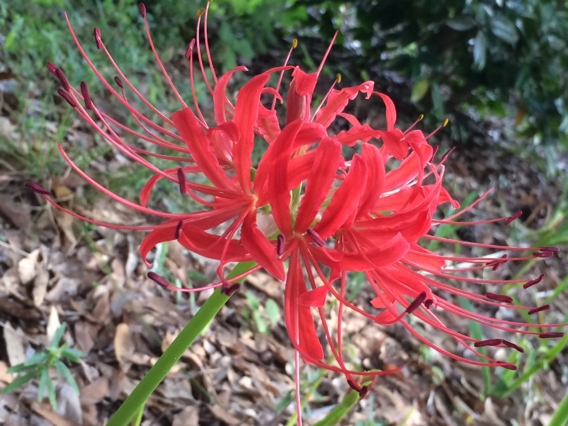Red Spider Lily
(Lycoris radiata)
Red Spider Lily (Lycoris radiata)
/
/

Laura Clark
CC BY 4.0
Image By:
Laura Clark
Recorded By:
Copyright:
CC BY 4.0
Copyright Notice:
Photo by: Laura Clark | License Type: CC BY 4.0 | License URL: http://creativecommons.org/licenses/by/4.0/ | Rights Holder: Laura Clark | Publisher: iNaturalist | Date Created: 2014-09-22T13:21:31Z |























Estimated Native Range
Summary
Lycoris radiata, commonly known as the red spider lily, is a bulbous perennial herb native to woodlands, grasslands, and along riverbanks in China, Japan, Korea, and Nepal. It has also naturalized in regions such as the Seychelles and the Ryukyu Islands. This plant is known for its striking, bright-red flowers with long, spindly stamens that resemble spider legs, which bloom in late summer or autumn, often after heavy rainfall. The red spider lily reaches a height of 12-28 inches with greyish-green, strap-shaped leaves that emerge in October and persist through winter, providing greenery even when the plant is not in flower.
The red spider lily is valued for its unique and showy flowers, which make it a popular choice for ornamental planting in gardens. It is often used in borders, as a focal point in floral displays, or in naturalized areas. In cultivation, it prefers full sun to part shade, well-drained soil, and moderate water. While it is relatively low-maintenance, it should be noted that the bulbs are toxic and should be handled with care, especially around pets and children. The plant has a cultural significance in Japan, where it is associated with fall and is often planted near gravesites. Despite its beauty, the red spider lily can be invasive in some regions outside its native range, so gardeners should be cautious about its potential to spread.CC BY-SA 4.0
The red spider lily is valued for its unique and showy flowers, which make it a popular choice for ornamental planting in gardens. It is often used in borders, as a focal point in floral displays, or in naturalized areas. In cultivation, it prefers full sun to part shade, well-drained soil, and moderate water. While it is relatively low-maintenance, it should be noted that the bulbs are toxic and should be handled with care, especially around pets and children. The plant has a cultural significance in Japan, where it is associated with fall and is often planted near gravesites. Despite its beauty, the red spider lily can be invasive in some regions outside its native range, so gardeners should be cautious about its potential to spread.CC BY-SA 4.0
Plant Description
- Plant Type: Herb, Bulb
- Height: 1-2 feet
- Width: 1-2 feet
- Growth Rate: Moderate
- Flower Color: Red
- Flowering Season: Summer, Fall
- Leaf Retention: Deciduous
Growth Requirements
- Sun: Full Sun, Part Shade
- Water: Medium
- Drainage: Fast, Medium
Common Uses
Border Plant, Butterfly Garden, Low Maintenance, Potted Plant, Rock Garden
Natural Habitat
Woodlands, grasslands, and along riverbanks
Other Names
Common Names: Red Magic Lily, Hell Flower, Shi Suan, Spider-Lily
Scientific Names: , Lycoris radiata, Amaryllis radiata, Lycoris radiata f. bicolor, Lycoris radiata var. kazukoana, Lycoris radiata var. pumila, Lycoris radiata var. radiata, Lycoris radiata var. terraccianii, Lycoris terracianii, Nerine japonica
GBIF Accepted Name: